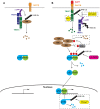Non-Canonical NF-κB Signaling Initiated by BAFF Influences B Cell Biology at Multiple Junctures
- PMID: 24432023
- PMCID: PMC3880999
- DOI: 10.3389/fimmu.2013.00509
Non-Canonical NF-κB Signaling Initiated by BAFF Influences B Cell Biology at Multiple Junctures
Abstract
It has been more than a decade since it was recognized that the nuclear factor of kappa light polypeptide gene enhancer in B cells (NF-κB) transcription factor family was activated by two distinct pathways: the canonical pathway involving NF-κB1 and the non-canonical pathway involving NF-κB2. During this time a great deal of evidence has been amassed on the ligands and receptors that activate these pathways, the cytoplasmic adapter molecules involved in transducing the signals from receptors to nucleus, and the resulting physiological outcomes within body tissues. In contrast to NF-κB1 signaling, which can be activated by a wide variety of receptors, the NF-κB2 pathway is typically only activated by a subset of receptor and ligand pairs belonging to the tumor necrosis factor (TNF) family. Amongst these is B cell activating factor of the TNF family (BAFF) and its receptor BAFFR. Whilst BAFF is produced by many cell types throughout the body, BAFFR expression appears to be restricted to the hematopoietic lineage and B cells in particular. For this reason, the main physiological outcomes of BAFF mediated NF-κB2 activation are confined to B cells. Indeed BAFF mediated NF-κB2 signaling contributes to peripheral B cell survival and maturation as well as playing a role in antibody responses and long term maintenance plasma cells. Thus the importance BAFF and NF-κB2 permeates the entire B cell lifespan and impacts on this important component of the immune system in a variety of ways.
Keywords: B lymphocyte; BAFF; BAFFR; NF-κB2; signaling.
Figures


Similar articles
-
An atypical tumor necrosis factor (TNF) receptor-associated factor-binding motif of B cell-activating factor belonging to the TNF family (BAFF) receptor mediates induction of the noncanonical NF-kappaB signaling pathway.J Biol Chem. 2005 Mar 18;280(11):10018-24. doi: 10.1074/jbc.M413634200. Epub 2005 Jan 11. J Biol Chem. 2005. PMID: 15644327
-
TACI induces cIAP1-mediated ubiquitination of NIK by TRAF2 and TANK to limit non-canonical NF-kappaB signaling.J Recept Signal Transduct Res. 2010 Apr;30(2):121-32. doi: 10.3109/10799891003634509. J Recept Signal Transduct Res. 2010. PMID: 20184394
-
A role of both NF-κB pathways in expression and transcription regulation of BAFF-R gene in multiple myeloma cells.Mol Cell Biochem. 2011 Nov;357(1-2):21-30. doi: 10.1007/s11010-011-0871-9. Epub 2011 May 24. Mol Cell Biochem. 2011. PMID: 21607696
-
Roles of TRAFs in NF-κB signaling pathways mediated by BAFF.Immunol Lett. 2018 Apr;196:113-118. doi: 10.1016/j.imlet.2018.01.010. Epub 2018 Feb 20. Immunol Lett. 2018. PMID: 29378215 Review.
-
How do nuclear factor kappa B (NF-κB)1 and NF-κB2 defects lead to the incidence of clinical and immunological manifestations of inborn errors of immunity?Expert Rev Clin Immunol. 2023 Mar;19(3):329-339. doi: 10.1080/1744666X.2023.2174105. Epub 2023 Feb 9. Expert Rev Clin Immunol. 2023. PMID: 36706462 Review.
Cited by
-
Animal Models of Interferon Signature Positive Lupus.Front Immunol. 2015 Jun 5;6:291. doi: 10.3389/fimmu.2015.00291. eCollection 2015. Front Immunol. 2015. PMID: 26097482 Free PMC article. Review.
-
Neutralization of B-Cell Activating Factor (BAFF) by Belimumab Reinforces Small Molecule Inhibitor Treatment in Chronic Lymphocytic Leukemia.Cancers (Basel). 2020 Sep 23;12(10):2725. doi: 10.3390/cancers12102725. Cancers (Basel). 2020. PMID: 32977449 Free PMC article.
-
Pleiotropic effects of BAFF on the senescence-associated secretome and growth arrest.Elife. 2023 Apr 21;12:e84238. doi: 10.7554/eLife.84238. Elife. 2023. PMID: 37083495 Free PMC article.
-
Differential requirements for the canonical NF-κB transcription factors c-REL and RELA during the generation and activation of mature B cells.Immunol Cell Biol. 2017 Mar;95(3):261-271. doi: 10.1038/icb.2016.95. Epub 2016 Sep 21. Immunol Cell Biol. 2017. PMID: 27649781 Free PMC article.
-
Reactive oxygen species in biological systems: Pathways, associated diseases, and potential inhibitors-A review.Food Sci Nutr. 2023 Dec 1;12(2):675-693. doi: 10.1002/fsn3.3784. eCollection 2024 Feb. Food Sci Nutr. 2023. PMID: 38370049 Free PMC article. Review.
References
-
- Hauer J, Puschner S, Ramakrishnan P, Simon U, Bongers M, Federle C, et al. TNF receptor (TNFR)-associated factor (TRAF) 3 serves as an inhibitor of TRAF2/5-mediated activation of the noncanonical NF-kappaB pathway by TRAF-binding TNFRs. Proc Natl Acad Sci U S A (2005) 102:2874–910.1073/pnas.0500187102 - DOI - PMC - PubMed
Publication types
LinkOut - more resources
Full Text Sources
Other Literature Sources
Molecular Biology Databases

